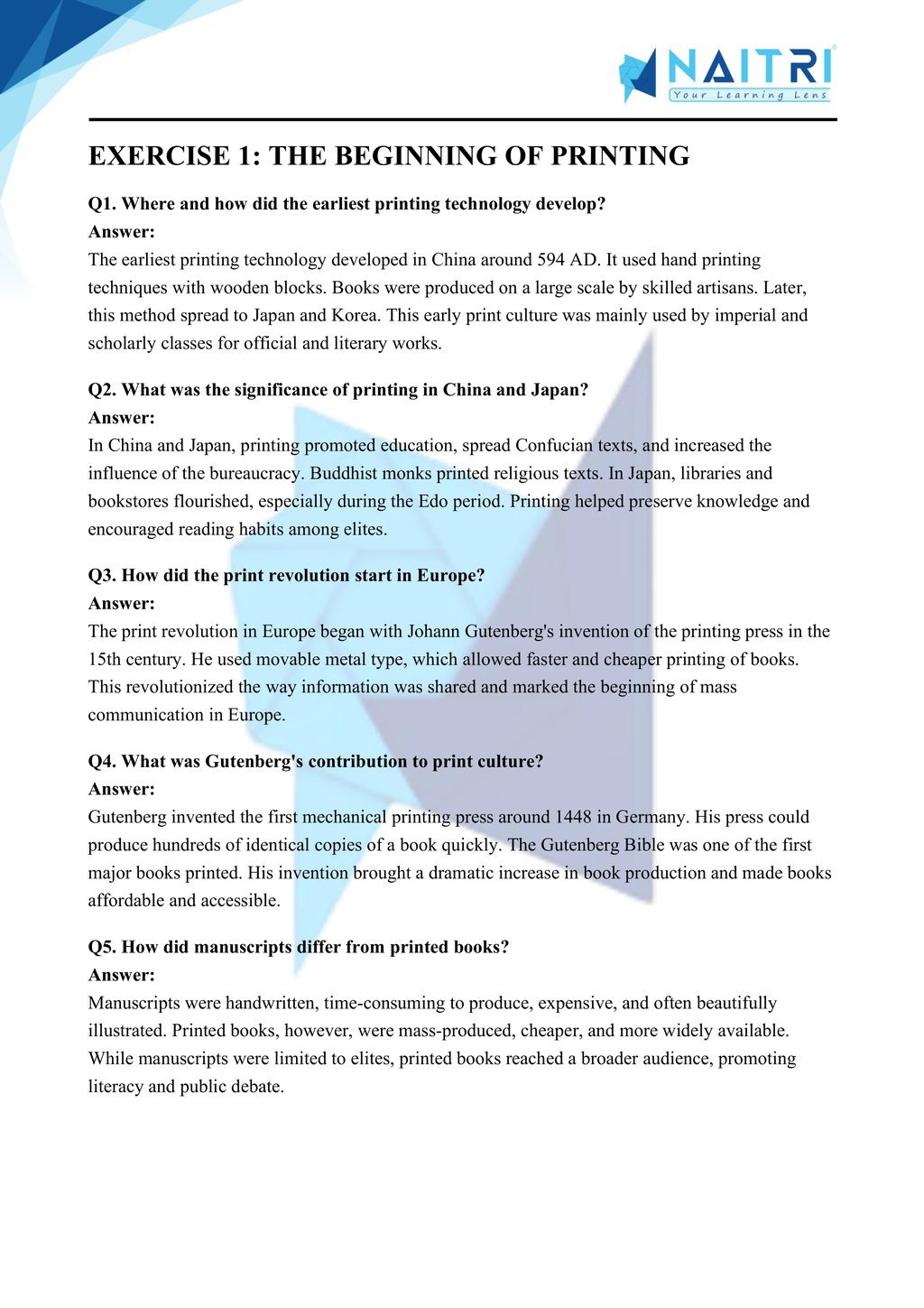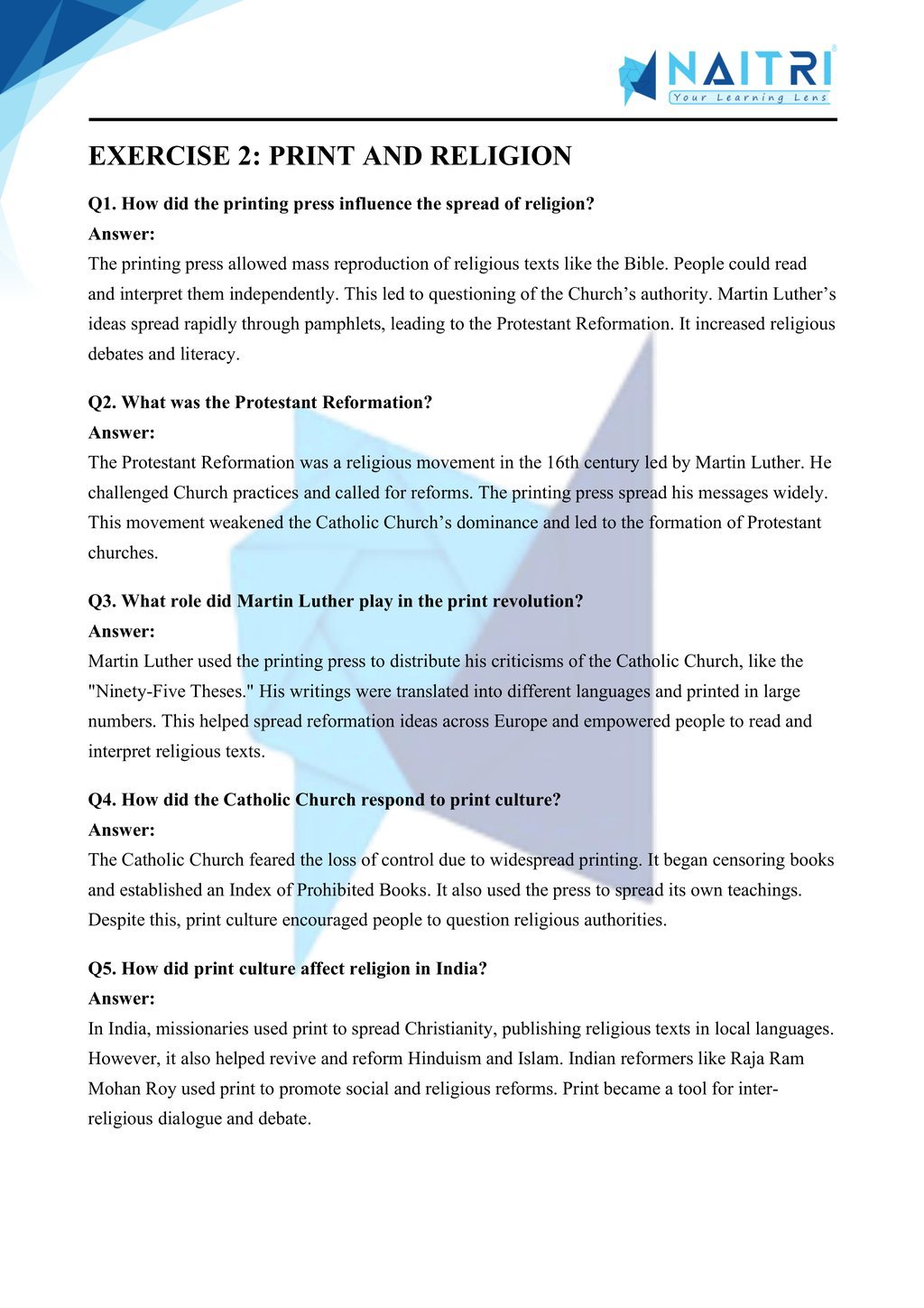MP Board Solutions for Class 10 History Chapter 5 – Print Culture and the Modern World
MP Board Solutions for Class 10 History Chapter 5 – Print Culture and the Modern World are essential for understanding the role of print in shaping society and politics in the MPBSE curriculum. These well-structured answers help students grasp topics like the invention of the printing press, the spread of literacy, social reform movements, and print’s influence on national and cultural identities. Designed as per the latest syllabus, these solutions strengthen conceptual clarity and improve exam preparation. Ideal for revision and practice, they explore how print transformed modern societies, making them a valuable study tool for scoring well in Class 10 Social Science exams.
MP Board Solutions For Class 10 History – Print Culture and the Modern World – Exercise Images





Experience History Like Never Before – With AR!
Understanding Print Culture and the Modern World is now more exciting and immersive! With the NAITRI App, you can explore complex history concepts through Augmented Reality (AR). See books roll off presses, ideas spread across continents, and revolutions spark through print — right in front of you. Our AR-powered lessons make learning interactive, 3D, and fun, helping you retain concepts better and enjoy every topic.



Visualize . Interact . Understand . The future of learning is here
Print Culture and the Modern World – Important Questions with Answers
Where and when did the printing press first develop?
Answer: The printing press was first developed by Johann Gutenberg in Germany around 1440. It revolutionized the way knowledge and information were shared.What was the impact of the printing press in Europe?
Answer: It led to rapid spread of ideas, growth of literacy, and questioning of religious and political authorities, especially during the Reformation and Enlightenment.What is manuscript culture?
Answer: Manuscript culture involved writing by hand on palm leaves or paper. It was time-consuming, expensive, and limited the spread of knowledge to the elite.Why did people prefer printed books over manuscripts?
Answer: Printed books were cheaper, more durable, and easily available. They helped ideas spread to a wider audienceand encouraged reading among common people.What were the earliest printed books in India?
Answer: The earliest Indian printed books were religious texts, printed by missionaries in Goa in the 16th century, in languages like Konkani and Tamil.How did the print revolution affect the Reformation?
Answer: The printing press helped spread Martin Luther’s 95 Theses, enabling rapid circulation of his criticism of the Church, sparking the Protestant Reformation.What was the role of print in the French Revolution?
Answer: Print helped spread revolutionary ideas like liberty, equality, and fraternity, and played a crucial role in shaping public opinion against monarchy and aristocracy.How did the printing press affect literacy rates in Europe?
Answer: With more affordable books and increased availability, the printing press encouraged reading habits and improved literacy rates among the common people.How did children’s literature grow during the print revolution?
Answer: Publishers began printing illustrated stories, fables, and educational books specifically for children, promoting early literacy and moral development.What were penny chapbooks?
Answer: Penny chapbooks were cheap, small books sold by peddlers in 19th-century Europe, containing stories, ballads, and tales for the common people.What was the significance of almanacs?
Answer: Almanacs provided weather forecasts, religious dates, and daily advice. They were widely read by peasants and became a key part of popular print culture.What was the impact of print on Indian social reform movements?
Answer: Reformers used print to spread ideas on caste, gender, and social evils. Journals and newspapers helped mobilize public opinion for change.How did print help in spreading nationalism in India?
Answer: Print united people through patriotic literature, freedom movement coverage, and circulation of Swadeshiideas, strengthening the nationalist consciousness against British rule.What role did vernacular press play in India?
Answer: Vernacular press published in regional languages, making information accessible to common people and promoting local culture, reform, and anti-colonial messages.Why did the British government censor the Indian press?
Answer: The government feared that print would spread rebellious ideas, so it imposed press laws to curb criticism and suppress nationalist writings.What was the Vernacular Press Act of 1878?
Answer: This act allowed the British to confiscate vernacular newspapers and punish publishers if content was deemed seditious or anti-government.Name any two early nationalist newspapers.
Answer: Kesari (by Bal Gangadhar Tilak) and Amrita Bazar Patrika were nationalist newspapers that strongly criticized British policies and spread freedom movement ideas.What were the implications of print for women in India?
Answer: Print promoted education for women, gave voice to women reformers, and sparked debates on social customslike child marriage and purdah.How did religious groups respond to print in colonial India?
Answer: Both Hindus and Muslims used print to spread religious texts and defend beliefs. This sometimes led to religious debates and tension.What was the role of caricatures and cartoons in print culture?
Answer: Cartoons and caricatures in newspapers used humor and satire to criticize colonial rule, social practices, and raise public awareness.How did print culture impact workers and peasants?
Answer: Through pamphlets and low-cost books, workers and peasants could access ideas on rights, equality, and oppression, contributing to growing political awareness.What were the printing innovations in the 19th century?
Answer: New techniques like rotary press, offset printing, and better paper quality made printing faster and more affordable, increasing book production worldwide.What were the limits of print culture in the 19th century?
Answer: Despite increased printing, illiteracy, poverty, and lack of access to education limited the reach of printed material, especially in rural India.How did print culture influence reformers like Raja Ram Mohan Roy?
Answer: Reformers used print to question social evils, promote modern education, and spread progressive ideas to wider audiences through journals and pamphlets.What is the overall impact of print culture on modern society?
Answer: Print democratized knowledge, spread reformist and political ideas, enabled mass education, and laid the foundation for modern democratic discourse and activism.
Print Culture and the Modern World traces the history of print—from its origins in China and Europe to its impact on Indian society. It examines how the printing press influenced literacy, religious reform, political debate, and the growth of nationalism. The chapter also covers the role of print in social movements, public opinion, and the freedom struggle. It emphasizes how access to printed material helped shape modern democratic thought.
Download Naitri App
Easy, Visual Learning — Right on Your Phone
Learn with Augmented Reality! The Naitri app makes CBSE and MP Board concepts interactive and fun — even in low-resource settings. Watch lessons, complete homework, take tests, and track progress — all in one place. Anytime. Anywhere.
Available on








